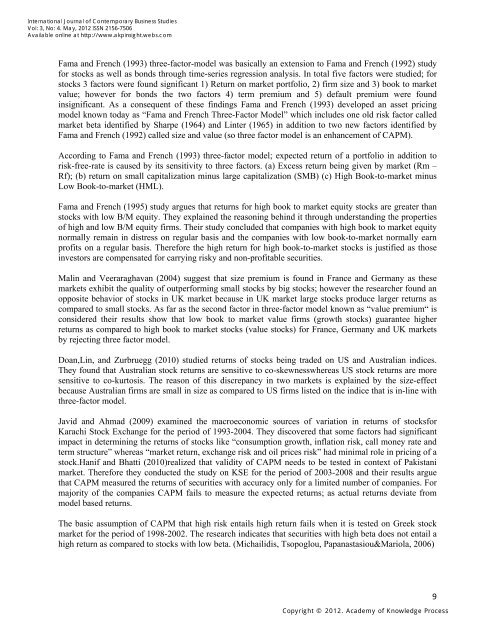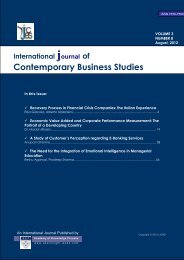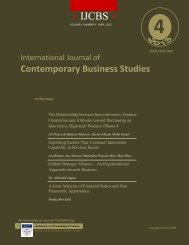International Journal of Contemporary Business Studies
International Journal of Contemporary Business Studies
International Journal of Contemporary Business Studies
You also want an ePaper? Increase the reach of your titles
YUMPU automatically turns print PDFs into web optimized ePapers that Google loves.
<strong>International</strong> <strong>Journal</strong> <strong>of</strong> <strong>Contemporary</strong> <strong>Business</strong> <strong>Studies</strong>Vol: 3, No: 4. May, 2012 ISSN 2156-7506Available online at http://www.akpinsight.webs.comFama and French (1993) three-factor-model was basically an extension to Fama and French (1992) studyfor stocks as well as bonds through time-series regression analysis. In total five factors were studied; forstocks 3 factors were found significant 1) Return on market portfolio, 2) firm size and 3) book to marketvalue; however for bonds the two factors 4) term premium and 5) default premium were foundinsignificant. As a consequent <strong>of</strong> these findings Fama and French (1993) developed an asset pricingmodel known today as “Fama and French Three-Factor Model” which includes one old risk factor calledmarket beta identified by Sharpe (1964) and Linter (1965) in addition to two new factors identified byFama and French (1992) called size and value (so three factor model is an enhancement <strong>of</strong> CAPM).According to Fama and French (1993) three-factor model; expected return <strong>of</strong> a portfolio in addition torisk-free-rate is caused by its sensitivity to three factors. (a) Excess return being given by market (Rm –Rf); (b) return on small capitalization minus large capitalization (SMB) (c) High Book-to-market minusLow Book-to-market (HML).Fama and French (1995) study argues that returns for high book to market equity stocks are greater thanstocks with low B/M equity. They explained the reasoning behind it through understanding the properties<strong>of</strong> high and low B/M equity firms. Their study concluded that companies with high book to market equitynormally remain in distress on regular basis and the companies with low book-to-market normally earnpr<strong>of</strong>its on a regular basis. Therefore the high return for high book-to-market stocks is justified as thoseinvestors are compensated for carrying risky and non-pr<strong>of</strong>itable securities.Malin and Veeraraghavan (2004) suggest that size premium is found in France and Germany as thesemarkets exhibit the quality <strong>of</strong> outperforming small stocks by big stocks; however the researcher found anopposite behavior <strong>of</strong> stocks in UK market because in UK market large stocks produce larger returns ascompared to small stocks. As far as the second factor in three-factor model known as “value premium“ isconsidered their results show that low book to market value firms (growth stocks) guarantee higherreturns as compared to high book to market stocks (value stocks) for France, Germany and UK marketsby rejecting three factor model.Doan,Lin, and Zurbruegg (2010) studied returns <strong>of</strong> stocks being traded on US and Australian indices.They found that Australian stock returns are sensitive to co-skewnesswhereas US stock returns are moresensitive to co-kurtosis. The reason <strong>of</strong> this discrepancy in two markets is explained by the size-effectbecause Australian firms are small in size as compared to US firms listed on the indice that is in-line withthree-factor model.Javid and Ahmad (2009) examined the macroeconomic sources <strong>of</strong> variation in returns <strong>of</strong> stocksforKarachi Stock Exchange for the period <strong>of</strong> 1993-2004. They discovered that some factors had significantimpact in determining the returns <strong>of</strong> stocks like “consumption growth, inflation risk, call money rate andterm structure” whereas “market return, exchange risk and oil prices risk” had minimal role in pricing <strong>of</strong> astock.Hanif and Bhatti (2010)realized that validity <strong>of</strong> CAPM needs to be tested in context <strong>of</strong> Pakistanimarket. Therefore they conducted the study on KSE for the period <strong>of</strong> 2003-2008 and their results arguethat CAPM measured the returns <strong>of</strong> securities with accuracy only for a limited number <strong>of</strong> companies. Formajority <strong>of</strong> the companies CAPM fails to measure the expected returns; as actual returns deviate frommodel based returns.The basic assumption <strong>of</strong> CAPM that high risk entails high return fails when it is tested on Greek stockmarket for the period <strong>of</strong> 1998-2002. The research indicates that securities with high beta does not entail ahigh return as compared to stocks with low beta. (Michailidis, Tsopoglou, Papanastasiou&Mariola, 2006)Copyright © 2012. Academy <strong>of</strong> Knowledge Process9
















